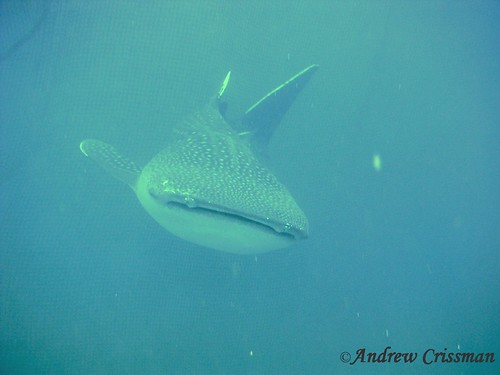

"You want me to get in the water with that?" you ask, as a spotted 35-foot sea monster surges into view below your sub at Ningaloo Reef. It's a whale shark--which is not a whale, but Father the world's largest fish--and it's your mission to snap a close-up. "They look even bigger underwater," says Brad Norman, a whale shark researcher.
You see what he means as you begin swimming beside the huge fish. The eyes swivel to watch you, but you're not afraid. Whale sharks would rather eat tiny plankton that they sift through their gills than munch on curious swimmers. Their skin is covered in white spots. You photograph the spots to accomplish your mission.
Back on the sub, Norman uploads your picture to ECOCEAN, a conservation program that coordinates whale shark identification. The system analyzes the spots in your photo and tries to match them with pictures submitted by adventurous tourists from all over the world. "Each shark has a unique pattern of spots," Norman says. "It's like a fingerprint." The spot-matching system helps researchers track the fish's travels and monitor the species' overall health.
Every photo helps. Plankton-rich waters attract the elusive sharks, but they also spend many days in deeper water--far from cameras. By keeping tabs on the whale sharks through photos, scientists get crucial information about more than the sharks. "Because they feed on tiny prey and must find lots of it, this species could become an indicator of the health of our marine ecosystem," Norman says.
[ILLUSTRATION OMITTED]
> > IM
* GO TO THAT WEB SITE FROM YESTERDAY AGAIN.
* WHY?
* TRACK WHALE SHARKS & KEEP EYE ON OCEAN HEALTH.
* HOW?
* EAT PLANKTON.
* UMMM ... NO THANKS.
* NOT U! SHARKS. SICK SEA = PLANKTON GONE = NO FOOD FOR SHARKS.
[ILLUSTRATION OMITTED]
STOP 4
YOU ARE HERE
[ILLUSTRATION OMITTED]
MORE ABOUT AUSTRALIA'S WATERS
ARE THOSE LITTLE BRITTLE STARS HOLDING HANDS?
Nope. They are simply sitting on the top of a seamount (an underwater mountain), snagging food as water flows by. Scientists off the coast of New Zealand found a "brittle star city" on top of a seamount almost 2,500 feet tall.
[ILLUSTRATION OMITTED]
KEEP YOUR EYES PEELED The waters around Australia are home to one of the world's smallest fish. The stout infantfish is no longer than the width of a pencil and one of the smallest animals with a backbone on the planet.
[ILLUSTRATION OMITTED]
THE BLOBFISH looks more like a cartoon character than a fish. Its lazy strategy is probably simply to wait for something edible to swim by as it hangs out near the ocean floor.
A SMALL BLUE-RINGED OCTOPUS scurries along the ocean floor, looking for crabs to eat. It may be beautiful to look at, but stay away: The colorful creature contains enough venom to kill several humans.
OCEAN FUN FACT
TAKING BREAKS FROM YOUR SUBMERSIBLE, you walk on beaches covered with seashells such as the conch. These shells are the exterior skeletons of soft-bodied animals called mollusks that grow inside. So make sure nothing is living in there when you pick up the shell!
Source Citation
"Whale sharks." National Geographic Kids Apr. 2009: 20+. Popular Magazines. Web. 31 Dec. 2009.
Gale Document Number:A206388391


No comments:
Post a Comment